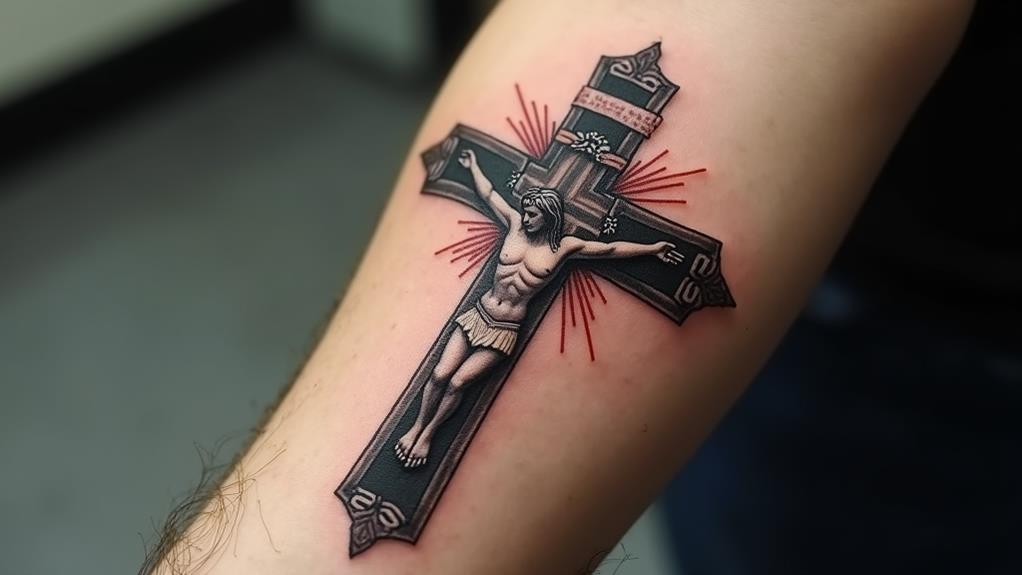Crucifix tattoos offer a powerful way to express faith through unique designs. I've seen minimalist styles with clean lines and geometric shapes that capture the essence of the symbol. Nature-inspired crosses blend organic elements like vines or flowers, symbolizing spiritual growth. Artistic typography crosses incorporate meaningful verses or quotes, adding layers of significance. Some designs blend cultural influences, combining Celtic knots or Maori patterns with traditional crucifixes. The placement of your tattoo can also hold symbolic meaning, from the back representing carrying your faith to the chest signifying a deep personal connection. There's a world of creative possibilities to explore in crucifix tattoo designs.
Minimalist Crucifix Designs
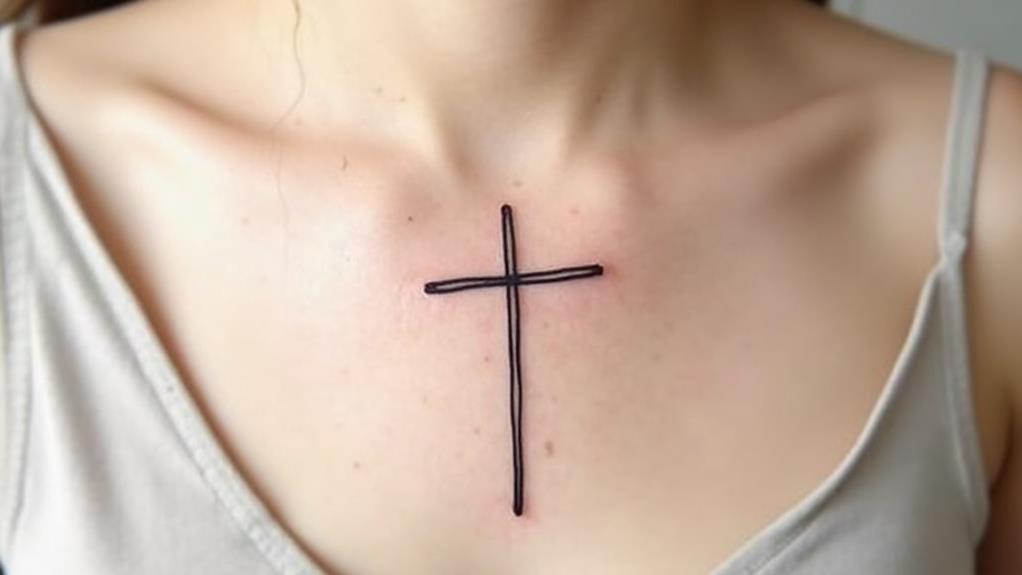
Increasingly, minimalist crucifix designs are gaining popularity among tattoo enthusiasts.
I've noticed a trend towards simple, clean lines that capture the essence of the crucifix without unnecessary embellishments. These designs often feature a single, continuous line forming the cross and figure of Christ, creating a powerful yet understated symbol of faith.
I've seen some truly innovative approaches to minimalist crucifix tattoos.
One striking design I encountered used negative space to form the cross, with the outline of Christ's body emerging from the surrounding ink.
Another style I admire incorporates geometric shapes, reducing the crucifix to its most basic elements while maintaining its spiritual significance.
What I find most appealing about these minimalist designs is their versatility.
They can be discreet enough for professional settings yet meaningful enough to serve as a constant reminder of one's beliefs.
I've also noticed that many people opt for small placements, such as the wrist or behind the ear, allowing for a personal and intimate expression of faith.
These simplified designs prove that sometimes, less truly is more when it comes to religious tattoos.
Incorporating Nature Elements
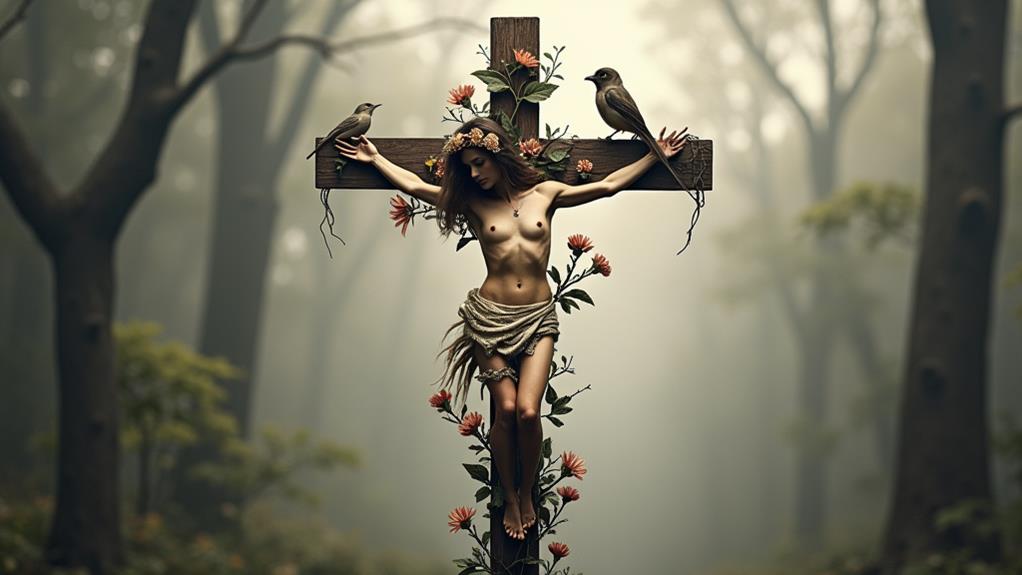
Harmony between faith and nature often inspires tattoo artists to incorporate organic elements into crucifix designs.
I've seen stunning pieces that blend the sacred symbol with the beauty of creation, resulting in unique and meaningful tattoos. These nature-infused crucifixes can represent the interconnectedness of faith and the natural world, or symbolize growth and renewal in one's spiritual journey.
Some popular ways to incorporate nature into crucifix tattoos include:
- Vines or branches forming the cross
- Flowers blooming from the crucifix
- Tree of life with a crucifix integrated into its trunk
- Animal silhouettes surrounding or intertwined with the cross
I find that these designs often evoke a sense of peace and connection to the divine through nature.
They can be particularly appealing to those who feel a strong spiritual presence in the outdoors.
When considering such a tattoo, I'd recommend working closely with an artist who understands both the religious significance and the natural elements you want to include.
This collaboration guarantees a personalized, respectful design that truly reflects your faith and appreciation for the natural world.
Artistic Typography Crosses
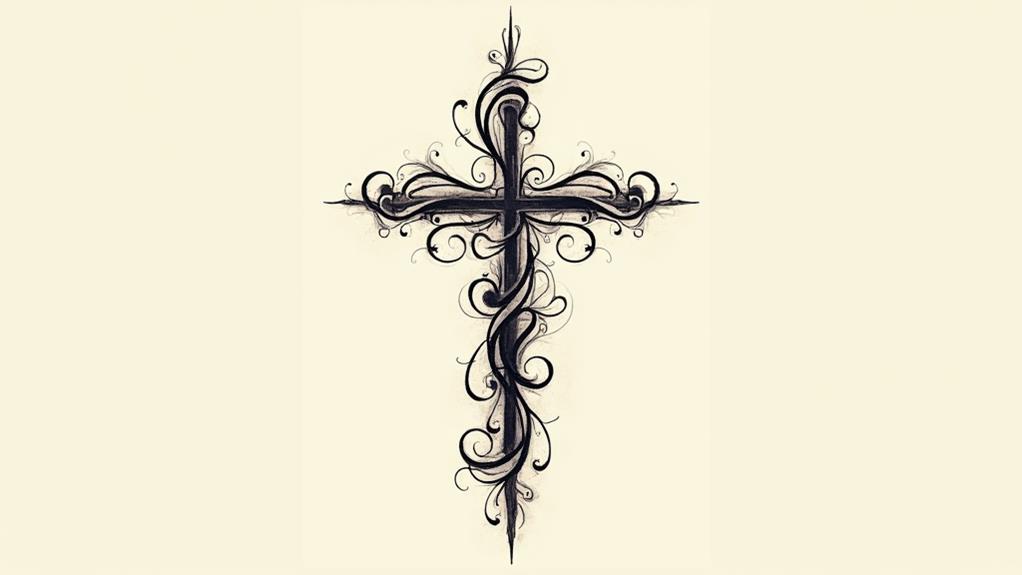
While nature-inspired designs offer a unique blend of faith and creation, artistic typography crosses take a different approach to expressing devotion through ink.
I've seen an increasing number of tattoo enthusiasts opting for these stylized crucifix designs, which blend religious symbolism with the art of lettering.
In these tattoos, the cross itself is formed using words or phrases of spiritual significance.
I've observed various techniques, from elegant calligraphy to bold, modern fonts.
Some popular choices include Bible verses, prayers, or meaningful quotes.
The words can follow the contours of the cross or be arranged in creative patterns within its shape.
What I find particularly striking about typography crosses is their ability to convey multiple layers of meaning.
They not only represent faith through the cross symbol but also communicate specific messages or beliefs through the chosen text.
This dual symbolism allows for a deeply personal and customizable tattoo experience.
I've noticed that these designs often appeal to those who want a more subtle or contemporary expression of their faith.
They're versatile, working well in various sizes and placements on the body.
Blending Cultural Influences
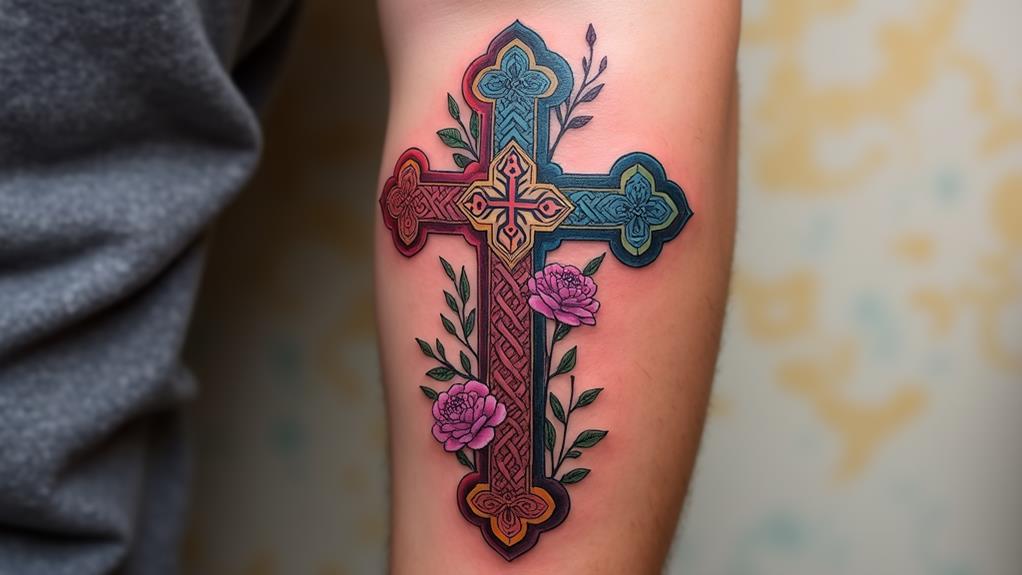
Crucifix tattoos have branched out to embrace diverse cultural influences, creating unique and meaningful designs.
I've seen how artists and tattoo enthusiasts blend different cultural elements to create stunning crucifix tattoos that tell a personal story.
By incorporating symbols, patterns, and artistic styles from various cultures, these tattoos become a powerful representation of faith and heritage.
Some popular cultural influences I've noticed in crucifix tattoos include:
- Celtic knots and interlacing patterns
- Maori-inspired tribal designs
- Japanese-style waves and cherry blossoms
- Mexican Day of the Dead sugar skull motifs
These cross-cultural designs often result in intricate, visually striking tattoos that carry deep personal significance.
I've observed how blending cultural influences can add layers of meaning to a crucifix tattoo, reflecting the wearer's diverse background or spiritual journey.
It's fascinating to see how these tattoos can serve as a bridge between different cultures and beliefs, creating a unique expression of faith that goes beyond traditional religious boundaries.
The fusion of cultural elements in crucifix tattoos demonstrates the universality of spiritual symbolism and the power of art to transcend cultural divides.
Symbolic Placement Considerations
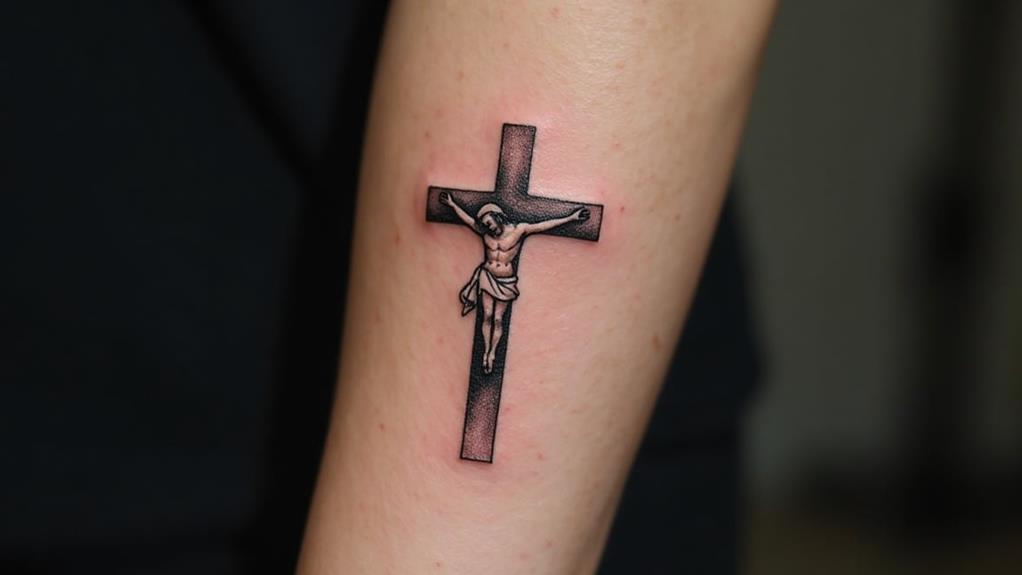
The placement of a crucifix tattoo carries its own symbolic weight, adding another layer of meaning to this powerful religious emblem.
I've found that many people choose to place their crucifix tattoos on areas of the body that hold personal significance or enhance the tattoo's symbolism. The back, for instance, can represent carrying one's faith or burdens, much like Jesus carried the cross.
A crucifix on the chest, over the heart, often signifies a deep, personal connection to one's faith. Wrist placements can serve as constant reminders of devotion, while finger tattoos may represent a commitment similar to a wedding ring.
I've noticed that some opt for more visible locations, like the forearm or calf, as a way to openly express their faith. Others prefer discreet placements, such as the ribcage or ankle, for a more private expression.
The shoulder blade can symbolize protection, while a crucifix on the nape of the neck might represent submission to one's beliefs.
Frequently Asked Questions
How Painful Is Getting a Crucifix Tattoo Compared to Other Designs?
I'd say a crucifix tattoo's pain level isn't necessarily different from other designs. It's more about the tattoo's location on your body. Areas with thin skin or close to bones tend to be more painful.
Can Crucifix Tattoos Be Easily Covered up if Needed?
I'd say covering up a crucifix tattoo can be challenging, depending on its size and detail. It's often possible with a skilled artist, but you'll need a larger, darker design to effectively conceal it. Consider your options carefully.
Are There Religious Restrictions on Getting Crucifix Tattoos?
I'd say it depends on your specific religious denomination. Some churches discourage tattoos in general, while others are more accepting. It's best to consult your religious leader or community for guidance on crucifix tattoos specifically.
How Long Does a Typical Crucifix Tattoo Take to Heal Completely?
From my experience, a crucifix tattoo typically takes about 2-3 weeks to heal on the surface. However, I've learned that complete healing beneath the skin can take up to 6 months. It's vital to follow aftercare instructions.
What Are the Potential Career Implications of Visible Crucifix Tattoos?
I'd say visible crucifix tattoos can impact careers differently depending on the industry. Some conservative fields might view them negatively, while creative industries may be more accepting. It's wise to ponder placement carefully for professional flexibility.
